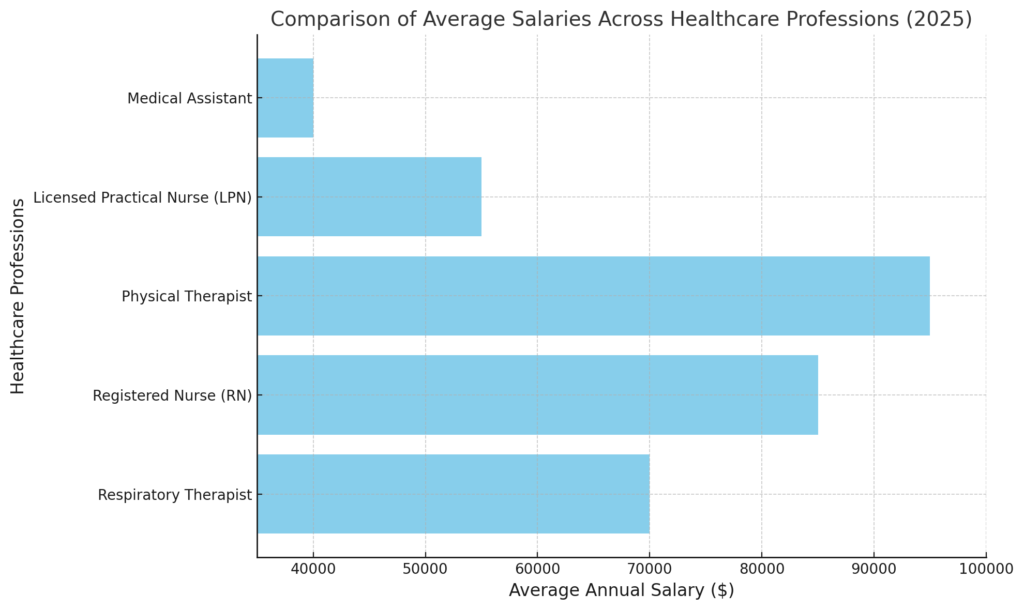Respiratory therapists (RTs) play a critical role in healthcare, assisting patients with breathing difficulties and managing conditions such as asthma, COPD, and pneumonia. If you’re considering a career in respiratory therapy or are already in the field, understanding the salary dynamics can help you plan your career path effectively. This article explores respiratory therapist salaries, factors influencing pay, regional variations, and the benefits of pursuing this rewarding career.
Average Salary of a Respiratory Therapist
The average annual salary for respiratory therapists in the United States in 2025 is approximately $70,000. However, salaries can range widely based on factors such as experience, education, certifications, and location. According to the U.S. Bureau of Labor Statistics (BLS), the median hourly wage for respiratory therapists is $33.65, translating to around $1,346 per week for full-time professionals.
| Experience Level | Average Annual Salary |
|---|---|
| Entry-Level (0-2 Years) | $55,000 – $60,000 |
| Mid-Career (3-7 Years) | $65,000 – $75,000 |
| Experienced (8+ Years) | $80,000 – $90,000+ |
Factors Influencing Salary
Several factors affect respiratory therapist salaries, including:
- Location: States such as California and New York tend to offer higher salaries due to higher living costs and demand for healthcare professionals. Conversely, states in the Midwest may have lower average wages but more affordable living conditions.
- Education and Certification: Holding an advanced degree or specialized certifications such as Neonatal/Pediatric Respiratory Care (NPS) can significantly boost earning potential.
- Type of Employer: Respiratory therapists working in hospitals or specialized clinics often earn more than those in smaller practices or nursing homes.
- Specialization: Therapists with expertise in specific areas like sleep studies or pulmonary rehabilitation may command higher salaries.
Regional Variations in Pay
The salary for respiratory therapists varies significantly by state and metropolitan area. For example:
- California: $85,000 – $100,000
- Texas: $65,000 – $75,000
- Florida: $60,000 – $70,000
- New York: $80,000 – $95,000
In rural areas, while salaries might be lower, there is often less competition for positions, making these regions attractive for new graduates.

Weekly Work Hours and Compensation
Most respiratory therapists work full-time, with a standard 40-hour workweek. However, shifts may vary, particularly in hospital settings, where night and weekend shifts are common. Many RTs receive overtime pay for hours exceeding the 40-hour threshold, with overtime rates often 1.5 times the regular hourly wage.
In addition to base pay, respiratory therapists often receive benefits such as health insurance, retirement plans, and paid time off. Some employers also offer tuition reimbursement and bonuses for certifications.
Comparing Respiratory Therapist Salaries to Other Healthcare Professions
When compared to other healthcare professions, respiratory therapists earn competitive salaries. For instance, the average salary for a respiratory therapist is around $70,000 per year, which is higher than that of licensed practical nurses (LPNs) who typically earn about $55,000 annually, but lower than the average salary of registered nurses (RNs) at $80,000 to $90,000 annually. Meanwhile, physical therapists, who require a doctorate-level education, earn approximately $90,000 to $100,000 per year. This places respiratory therapy as a solid middle-ground career in terms of income, requiring less educational investment than some higher-paying roles but offering significant earning potential and growth opportunities.

Job Outlook and Career Growth
The demand for respiratory therapists is expected to grow by 19% from 2021 to 2031, much faster than the average for all occupations. This growth is driven by an aging population and an increasing prevalence of respiratory conditions.
Opportunities for advancement include moving into supervisory roles, teaching positions, or specializing in advanced care areas such as neonatal respiratory therapy. These roles often come with higher pay and greater responsibilities.
A career as a respiratory therapist offers not only a stable income but also the opportunity to make a significant impact on patients’ lives. While the average salary is competitive, factors like location, specialization, and experience can influence earning potential. Whether you’re just starting in the field or looking to advance, understanding salary trends and job outlook can help you make informed decisions.
If you’re passionate about healthcare and helping others, respiratory therapy is a fulfilling and financially rewarding career to consider.
Frequently Asked Questions (FAQs)
1. What education is required to become a respiratory therapist?
To become a respiratory therapist, you typically need an Associate’s Degree in Respiratory Therapy. Additionally, many employers require certification as a Registered Respiratory Therapist (RRT). For greater earning potential and advancement opportunities, pursuing a Bachelor’s Degree is recommended.
2. Where do respiratory therapists earn the highest salaries?
Salaries are generally highest in states like California, New York, and Massachusetts. These states offer higher wages due to elevated living costs and greater demand for healthcare professionals.
3. How many hours do respiratory therapists work per week?
Most respiratory therapists work 40 hours per week. However, those employed in hospital settings often have rotating shifts, including nights, weekends, and holidays.
4. Are there opportunities for career advancement in respiratory therapy?
Yes, respiratory therapists can advance by obtaining specialized certifications, moving into supervisory or teaching roles, or focusing on areas like neonatal or pulmonary care. These advancements often come with higher salaries and increased responsibilities.
5. What is the job outlook for respiratory therapists?
The demand for respiratory therapists is projected to grow by 19% from 2021 to 2031, much faster than the average for all occupations. This growth is driven by an aging population and rising cases of chronic respiratory diseases.
6. Do respiratory therapists receive benefits?
Yes, most full-time respiratory therapists receive benefits, including health insurance, retirement plans, paid time off, and sometimes bonuses for certifications or continuing education.

